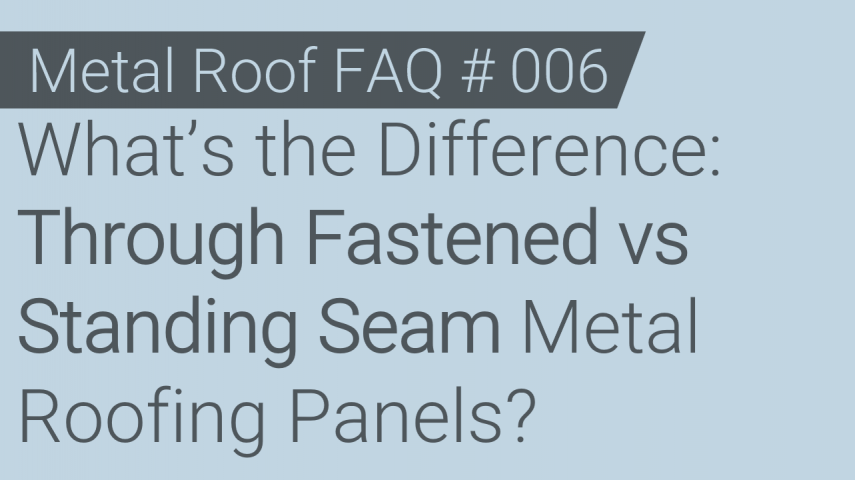Let’s Get Started
Take the next step - contact one of our experts or explore our full line of metal roof systems.
Contact Our Experts View Our Products
When considering a metal roofing panel, understanding the fundamental difference between through fastened and standing seam categories is a great place to start.
Through fastened panels are fastened with visible screws, while standing seam is fastened with hidden clips or screws.
The fasteners chosen for through fastened panels are galvanized or zinc plated, with a neoprene or EPDM rubber seal capped by a metal washer. These screws are painted to match the roof.
The fasteners for standing seam can be broken into two categories: a fastening flange which is screwed into, or a clip that hooks over the rib and is fastened into. The next panel is then snapped or seamed over the previous panel.
Through fastened panels typically look similar to a board and batten design, with trapezoidal major ribs often at 8″-12″ apart, and minor pencil ribs between the major ribs. Some profiles, such as 5V-Crimp, provide a thin seam style that is closer to the look of standing seam. Other profiles such as corrugated give that old wavy look.
Standing seam panels give a modern thin seam look, with narrow ribs often at 12″-18″ apart, and flatter spaces “pans” between the ribs. The pans may be striated with gentle low profile striations, have minor ribs, or be completely flat between the ribs. Striations are the most common as they reduce or eliminate oil canning (waviness on the flat surface of the pan).
Through fastened panels install faster than standing seam, with quickly installed coverage widths of 24″-36″. Trims also install quite fast.
Snap-together standing seam (hidden clip or hidden side flange) systems can be installed fairly quickly, while mechanically fastened standing seam (hidden clip) systems take longer. Trims are often designed to hide screws, which takes somewhat longer compared to through fastened panels.
Through fastened and standing seam roof systems both offer long life, with warranties typically at 40 years for paint and 30 years for fade and chalk.
On through fastened panels, screws should be inspected – typically after about 15-20 years. Often little to no maintenance is needed. Some screws may need tightened up, or in extreme cases you may have to replace screws.
A benefit of the hidden fasteners on standing seam is they never need to be inspected or replaced – standing seam is maintenance-free. Even after the 40-year warranty, you’ll have a strong, long-lasting warranty. You may consider repainting it somewhere near the 50-year mark, but hidden fasteners ensure a permanent roof solution.
Both through fastened and standing seam roofs look amazing, with beautiful colors and stunning curb appeal. Some people prefer the board & batten look, others the slim modern seams of standing seam. Regardless of the selection, a metal roof makes a great house look stunning.
Both through fastened and standing seam systems come in a wide variety of colors – through fastened about 20 and standing seam about 40. Both styles can also come in non-painted Galvalume, with a 25-year warranty typical.
Residential through fastened panels are often available in a 29 gauge or 26 gauge thickness (the lower the number the thicker the metal). Commercial through fastened panels are often available in a 26 gauge or 24 gauge thickness.
Standing Seam panels are often available in a 26 gauge or 24 gauge thickness.
Some ultra-heavy profiles may even come in a 22 gauge thickness in commercial through fastened or commercial standing seam profiles.
Take the next step - contact one of our experts or explore our full line of metal roof systems.
Contact Our Experts View Our Products